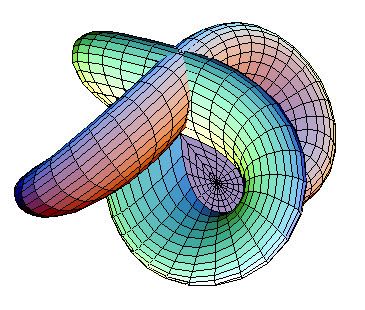 | ||
In mathematics, the homotopy principle (or h-principle) is a very general way to solve partial differential equations (PDEs), and more generally partial differential relations (PDRs). The h-principle is good for underdetermined PDEs or PDRs, such as occur in the immersion problem, isometric immersion problem, and other areas.
Contents
The theory was started by Yakov Eliashberg, Mikhail Gromov and Anthony V. Phillips. It was based on earlier results that reduced partial differential relations to homotopy, particularly for immersions. The first evidence of h-principle appeared in the Whitney–Graustein theorem. This was followed by the Nash-Kuiper Isometric
Rough idea
Assume we want to find a function ƒ on Rm which satisfies a partial differential equation of degree k, in co-ordinates
where
and some number of equations of the following type
A solution of
is called a non-holonomic solution, and a solution of the system (which is a solution of our original PDE) is called a holonomic solution.
In order to check whether a solution exists, first check if there is a non-holonomic solution (usually it is quite easy and if not then our original equation did not have any solutions).
A PDE satisfies the h-principle if any non-holonomic solution can be deformed into a holonomic one in the class of non-holonomic solutions. Thus in the presence of h-principle, a differential topological problem reduces to an algebraic topological problem. More explicitly this means that apart from the topological obstruction there is no other obstruction to the existence of a holonomic solution. The topological problem of finding a non-holonomic solution is much easier to handle and can be addressed with the obstruction theory for topological bundles.
Many underdetermined partial differential equations satisfy the h-principle. However, the falsity of an h-principle is also an interesting statement, intuitively this means the objects being studied have non-trivial geometry that cannot be reduced to topology. As an example, embedded Lagrangians in a symplectic manifold do not satisfy an h-principle, to prove this one needs to find invariants coming from pseudo-holomorphic curves.
Monotone functions
Perhaps the simplest partial differential relation is for the derivative to not vanish:
While this is a very simple example, it illustrates some of the general aspects of h-principles:
This example also extends to significant results: extending this to immersions of a circle into itself classifies them by order (or winding number), by lifting the map to the universal covering space and applying the above analysis to the resulting monotone map – the linear map corresponds to multiplying angle:
Smale's classification of immersions of spheres as the homotopy groups of Stiefel manifolds, and Hirsch's generalization of this to immersions of manifolds being classified as homotopy classes of maps of frame bundles are much further-reaching generalizations, and much more involved, but similar in principle – immersion requires the derivative to have rank k, which requires the partial derivatives in each direction to not vanish and to be linearly independent, and the resulting analog of the Gauss map is a map to the Stiefel manifold, or more generally between frame bundles.
A car in the plane
As another simple example, consider a car moving in the plane. The position of a car in the plane is determined by three parameters: two coordinates
since a non-skidding car must move in the direction of its wheels. In robotics terms, not all paths in the task space are holonomic.
A non-holonomic solution in this case, roughly speaking, corresponds to a motion of the car by sliding in the plane. In this case the non-holonomic solutions are not only homotopic to holonomic ones but also can be arbitrarily well approximated by the holonomic ones (by going back and forth, like parallel parking in a limited space) – note that this approximates both the position and the angle of the car arbitrarily closely. This implies that, theoretically, it is possible to parallel park in any space longer than the length of your car. It also implies that, in a contact 3 manifold, any curve is
While this example is simple, compare to the Nash embedding theorem, specifically the Nash–Kuiper theorem, which says that any short smooth (
Ways to prove the h-principle
Some paradoxes
Here we list a few counter-intuitive results which can be proved by applying the h-principle:
